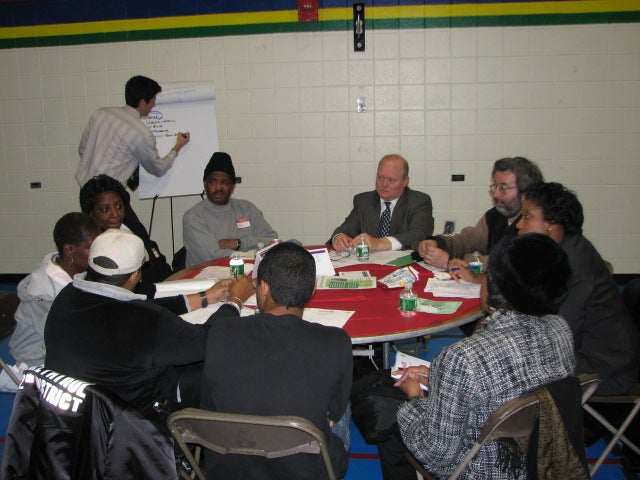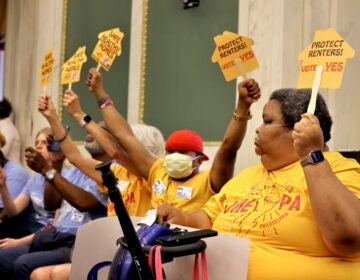West Philadelphians “imagine future”

Dec. 13
By Alan Jaffe
For PlanPhilly
Last week they met on South Broad Street, and then North Broad. Tuesday night they met in the Northeast. Tonight they met in West Philadelphia, on an indoor basketball court of the YMCA.
The fourth in a series of Imagine Philadelphia sessions, a public engagement process being coordinated by the City Planning Commission, looked at some of the city’s most serious ills, but also came up with some very upbeat remedies.
“We’re looking for ideas that will take Philadelphia into the future,” proposals that might not be realized until 2035, said Alan Urek, director of the CPC strategic planning and policy division.
It has been over four decades since the city developed a comprehensive municipal plan, but various forces have brought Philadelphia to a decisive crossroads and calls for a new plan, Urek explained. The population of the metropolitan area has shifted from core areas to the edges of the city. Regional growth and development have also become decentralized. Development pressures have threatened preservation of older structures. Traditional land uses have changed, as have transportation needs. At the same time, there is renewed interest in cities and redeveloping older areas, and in creating a modern city based on sustainable resources.
The more than 40 residents of West Philly and other parts of town were asked what they thought were the city’s greatest assets and its biggest problems, and what could make it better.
Several people agreed that this is an attractive city. Magali Larson, of University City, said whenever she returns from her native Italy, which has its own reputation for beauty, “I am always glad to come back to Philadelphia.”
Kimberly Strange-Shanks, of West Philadelphia, said she defends her hometown when her co-workers in Trenton deride it. “I talk about the neighborhoods, the historical sites, and what a beautiful city it is.”
Robert Avery, of North Philadelphia, said the city’s geographic location is an important asset. It
offers easy access to Washington, New York, and the Jersey Shore, he said.
But when they were asked what the city needed to change, that list quickly grew much longer.
Improved public schools are sorely needed, they said, particularly in the poorer neighborhoods, where the facilities require renovation and innovation.
The discussion turned often to alternative educational resources and training for those who won’t or can’t go on to college. Ronald Boyd explained that he dropped out of school at age 15. Today, at age 20, he’s back, however, attending YouthBuild Charter School in West Philadelphia. “We need more programs for drop-outs,” Boyd said, like his school, which teaches students how to rehabilitate low-income housing, in addition to classes in nursing and other skills. “The
school is based on employability,” he said.
The conversation also focused on businesses within the West Philadelphia communities. The 52nd Street commercial corridor, a half-block from where the meeting was held Wednesday night, had been very different a couple of decades ago, Strange-Shanks said. Its diverse mix of businesses and services is gone now, she said, “and it’s had a sad impact on our economy in this area.”
The business strip is still thriving at 4 p.m., but by 8 p.m. the iron grills come down and the street turns dark, others said. Avery said that crime has become a deterrent to business and customers in the area. “The mom-and-pop shops closed because it’s not as safe as it was back in the day,” he said. “It’s up to the neighborhoods to turn it around.”
But Strange-Shanks said part of the problem is that many business owners made their money and fled. “The businesses must work with the neighbors and stay in the neighborhood” to keep it strong, she said.
The residents said public and private re-investment are needed in the quality of life of the neighborhood, from sit-down restaurants and cafes, to simple requirements like mailboxes and trash containers. They also said the city must improve its public transit system.
Larson suggested “fast, small transportation,” like mini-buses and shuttles, “cheap taxis,” and other “agile, flexible” ways to get around town.
Others called for a second mass transportation system to give SEPTA a run for its money.
They also would like to see more recreational opportunities. Strange-Shanks wondered why the Kelly Drive, her “favorite part of the city,” was so well developed and active while the King Drive offered so little.
Avery had his own ideas for bringing residents and tourists to the Central Delaware waterfront, including a showboat or other entertainment center, and a Philadelphia wax museum highlighting
local figures past and present.
The Imagine Philadelphia discussions will continue next month with five more community meetings. The ideas gathered from the meetings will then be analyzed and recommendations will be prepared. Technical meetings with consultants, planning staff and other experts will follow, and policy papers will be created over the summer, Urek said.
A public presentation of the papers will be held in late summer or fall.
WHYY is your source for fact-based, in-depth journalism and information. As a nonprofit organization, we rely on financial support from readers like you. Please give today.






